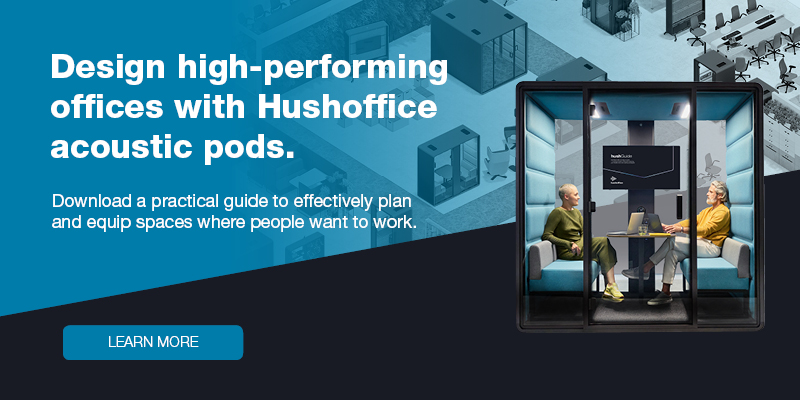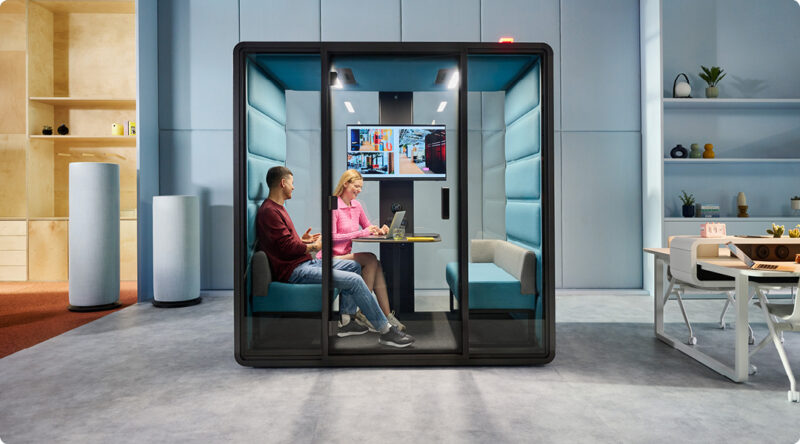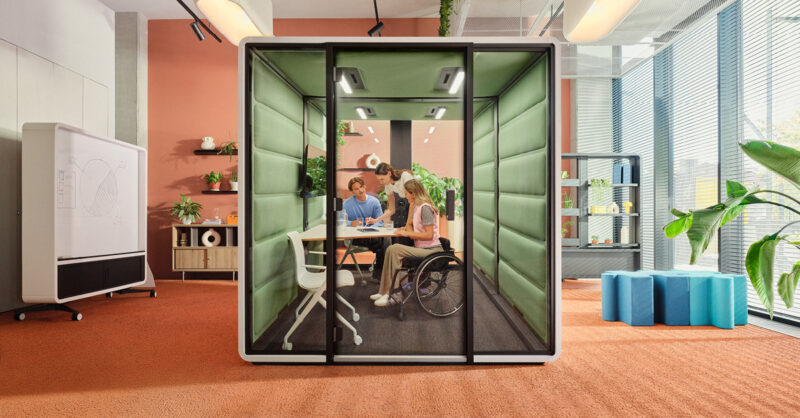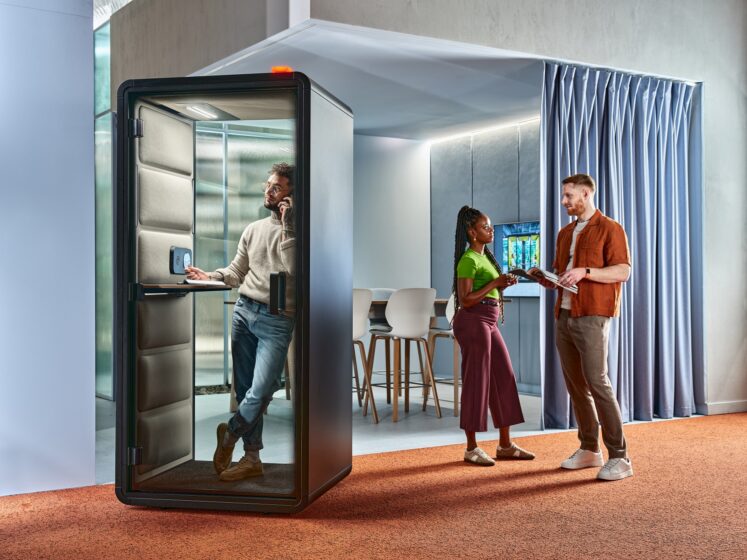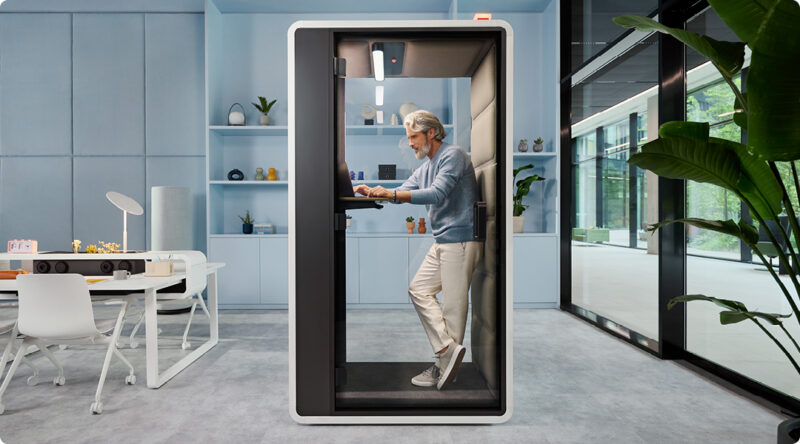The quick, comprehensive guide to office noise
- Posted on: 22 November 2021
- By: Hushoffice Team
Open office noise. Phones ring. Apps ping. Keyboards clickety-clack. Colleagues chat. The HVAC kicks on and off. Background office noise is also called “noise pollution,” fittingly. And it’s a severe problem with open layouts. Luckily, a few noise canceling and reduction solutions can restore ambiance.
Included Content…
-
Sound is a good thing. Beneficial, or biophilic sound is conducive to focus and well-being. This is why acoustic solutions like office pods and booths are comfortably quiet, not totally quiet. They convert a distracting ~70dB blare into a calming ~40dB hum.
-
10 best practices for managing office noise at an organizational level.
-
Solutions for each office acoustic problem… If your office echoes, add “fuzz” with soft, noise dampening material. If it’s uncomfortably quiet, consider a sound masking system. If it lacks speech privacy, look to speech privacy systems, space division, and office pods/booths. If it’s just plain noisy with calls, meetings, and collaboration, “trap” the worst noise offenders with acoustic cabins for the office.
-
The rule of thumb: where to place your acoustic treatments.
- 11 signs that portable, soundproof office pods are the right solution for your office noise problem.
The bad news, first: open office noise kills productivity.
A survey from the Leesman Review shows 76% of office workers list noise as a crucial workplace factor, yet only 30% are happy with the noise levels in their office. One study finds that listening to just one extra conversation can make us 66% less productive.
This makes sense when we consider that speech is regarded as the most distracting source of noise in an office. In fact, human-created sounds are one of the worst workplace distractions. And there’s even a link between office noise and burnout (check our post: Is the open space office burning people out?).
Some elementary education: office acoustics 101
But all is not lost! The right solutions can turn a cacophonous workplace into a calm one. First, let’s get some foundations out of the way. Key terms, the watered-down science of sound, and a core principle: why sound is a good thing.
Sound masking versus soundproofing
Sound masking and soundproofing are two very different animals.
What is office sound masking?
Office sound masking is the addition of natural or artificial sound to cover up unwanted, irritating noises. Another way to look at it: covering an unpleasant sound with a pleasant one that’s more soothing and diffuse. Also called “auditory masking.”
Adding the right sound to a space can make the space quieter.
Sounds counterintuitive, yes. But the new sound essentially blankets or “masks” noises, reducing speech intelligibility. And less intelligible speech is less attention-grabbing. Because our brain doesn’t register the speech as “speech” anymore, the space seems quieter. Wa-la.
Sound masking reduces the radius of distraction.
Or distance at which speech is intelligible from the speaker. Properly designed, the best white noise or sound masking machine for office privacy can’t actually be heard. It just becomes a background hum. Sometimes it’s engineered to match human speech. Sometimes it’s artificial office white noise — or “pink” or “brown” noise.
It also gives a workplace acoustical privacy.
It allows employees to focus thereby increasing productivity. Sound masking systems for the office include office noise makers, generators, and sound machines. They’re sometimes called privacy noise or sound machines. Some manufacturers also call them noise canceling, dampening, or masking machines and devices.
What is office soundproofing?
Office soundproofing is a method of controlling sound’s travel through the use of soft, sound-absorptive materials like decorative acoustic panels, soundproof foams, sound deadening curtains, soundproof paints, baffles, matting, and dividers. The list of solutions is virtually endless.
There are two basic approaches to office soundproofing…
1. Increase the distance between the sound source and receiver.
2. Implement sound-dampening barriers in the space to reflect or absorb sound energy (to intercept sound as it travels).
Soundproofing prevents resonance and reverberation.
It’s also called acoustical control or sound dampening, absorption, or insulation. Soundproofing is a simple way to improve office acoustics because it’s a simple matter of bringing in materials that absorb noise.
The science of sound, simplified
After a sound is made, it travels. As it travels, it’s either absorbed by soft materials, or “fuzz” (fabrics, foams, carpets…), or reflected by “hard” smooth surfaces (glass, steel, wood…). So if your space has a lot of hard materials and few soft materials, sound likely ricochets within it, bouncing off one hard surface after the next.
Sound is a good thing.
Now, for the pivotal point. Sound is a good thing! Beneficial, or biophilic sound, is conducive to focus and well-being. Think beach waves, babbling brooks, or light rain. Noise, on the other hand, is a bad thing. Defined as any sound that breaks attention or creates stress. I.e., all of those infamous workplace noises mentioned above.
So absolute quiet isn’t the goal.
No, no. Absolute quiet is actually uncomfortable and unhealthy for humans. Just check out the anechoic chamber, which can actually drive a person crazy.
Instead, acoustic ambiance is the goal.
Or a sound quality that just feels right. People get awkward and anxious in stark quiet spaces. They’re hyper-self-conscious of being overheard or distracting others. This is why acoustic solutions like office pods and booths are comfortably quiet, not totally quiet. They convert a disturbing ~70dB blare into a calming ~40dB hum. 70 dB is as loud as a dishwasher, while 40 dB is as quiet as the library.
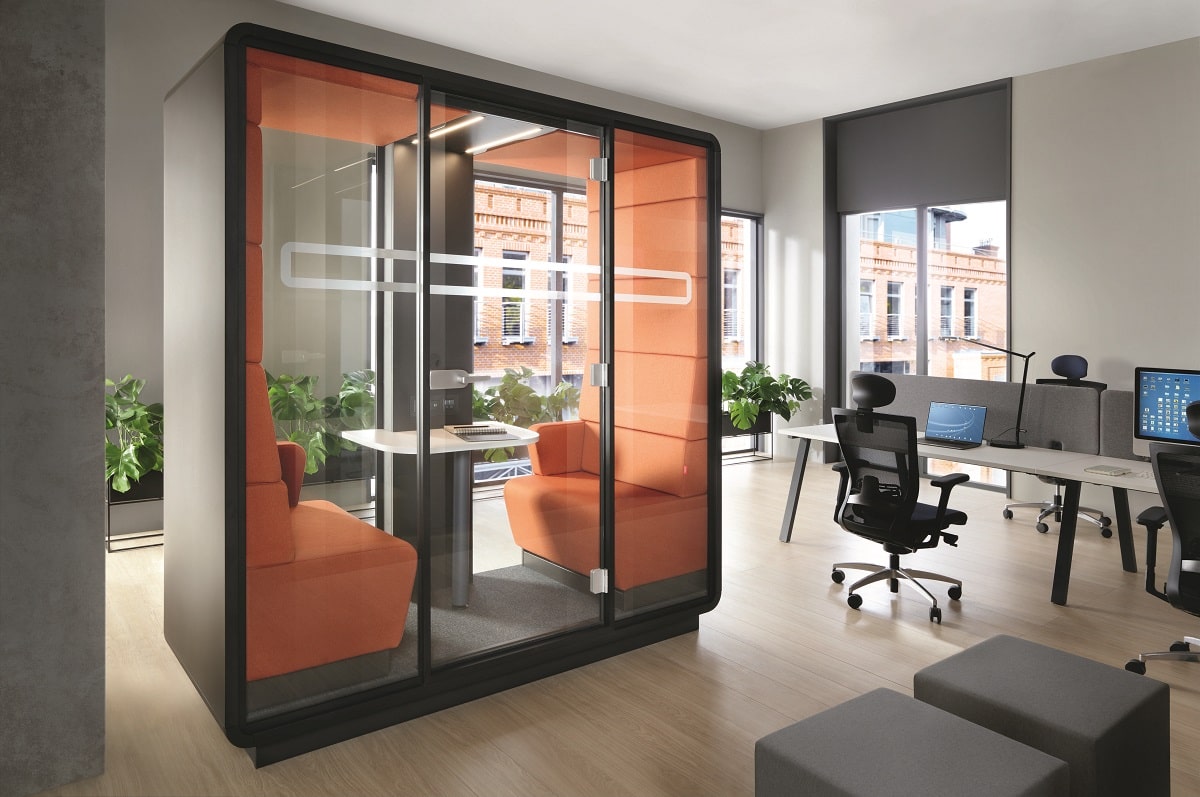
10 best practices for managing office noise at a high level
Where seats are assigned, strategically arrange project or department teams in groups. Separate groups using soundproof partitions of some sort. This way, teams that regularly collaborate can do so without bothering others.
Seat louder teammates or teams next to each other. Perhaps one department or project group tends to communicate or brainstorm solutions verbally on the regular. Seat these teammates together, distanced from quieter ones where possible. Say your accounting team needs relative privacy while your marketing team needs relative high-energy. Arranging teams in clusters helps satisfy everyone.
Make sure you have enough conference rooms. A lack of conference rooms is an open office noise problem for two reasons. First, focus on the open floor is regularly broken by meeting noise. Second, meeting attendee focus is stunted by that hyper-self-consciousness of being listened to. Consider a soundproofed conference booth like hushMeet.L as a flexible alternative to structural rooms. It’s modular, seating between 4-8 employees. Office booths and pods like hushMeet.L work because they’re carefully designed for private meetings.
Encourage your team to break for lunch in cafes, lounges, and patios instead of breaking in work areas.
Make sure you have enough private workspaces. Though the open space office harnesses collaboration exceptionally well when done right, some employees just can’t concentrate without peace and quiet. Private office work pods like hushWork.sit&stand are an attractive option, offering privacy, quiet, and an adjustable environment (lighting and ventilation).
Consider asking employees to set their devices to silent, so calls and push notifications aren’t upsetting anyone.
Keep machines like printers, faxes, and coffee makers in an enclosed room or zone separate from work areas.
Give employees places to take private calls. Quiet, acoustic privacy, and speech intelligibility are the crucial marks. Without them, call ease is hampered. Without them, the employee taking the call on-site is not only challenged by background office noise. They may also be unable to hear nuances in tone or tune into their own message to communicate it fluidly. If infrastructure is out of the question, consider a solution like the hushPhone office call booth. Mobile call booths for the office like hushPhone are highly functional, equipped with every feature needed for great calls. Because they’re portable, they give a team layout flexibility, too. Check out hushPhone’s specs.
Space-plan by soundscape. In layman’s terms, create “active” and “quiet” acoustic zones using sound dampening room dividers. Position them so that no zone impedes another’s effectiveness. Perhaps your breakroom zone gets rowdy and should be positioned far away from your deep work zone, which is always tranquil.
Provide private meeting spaces. In-person team meetings are staples in a hybrid, agile world. If your layout lacks such spaces, 3-4 person office meeting pods like hushMeet and 2-person acoustic meeting pods like hushMeet.S are popular products to consider. Meeting booth pods trap all meeting noise while supporting pure focus. They’re also mobile, giving the office awesome adjustability. Read more on this topic: 5 essential hybrid office investments.
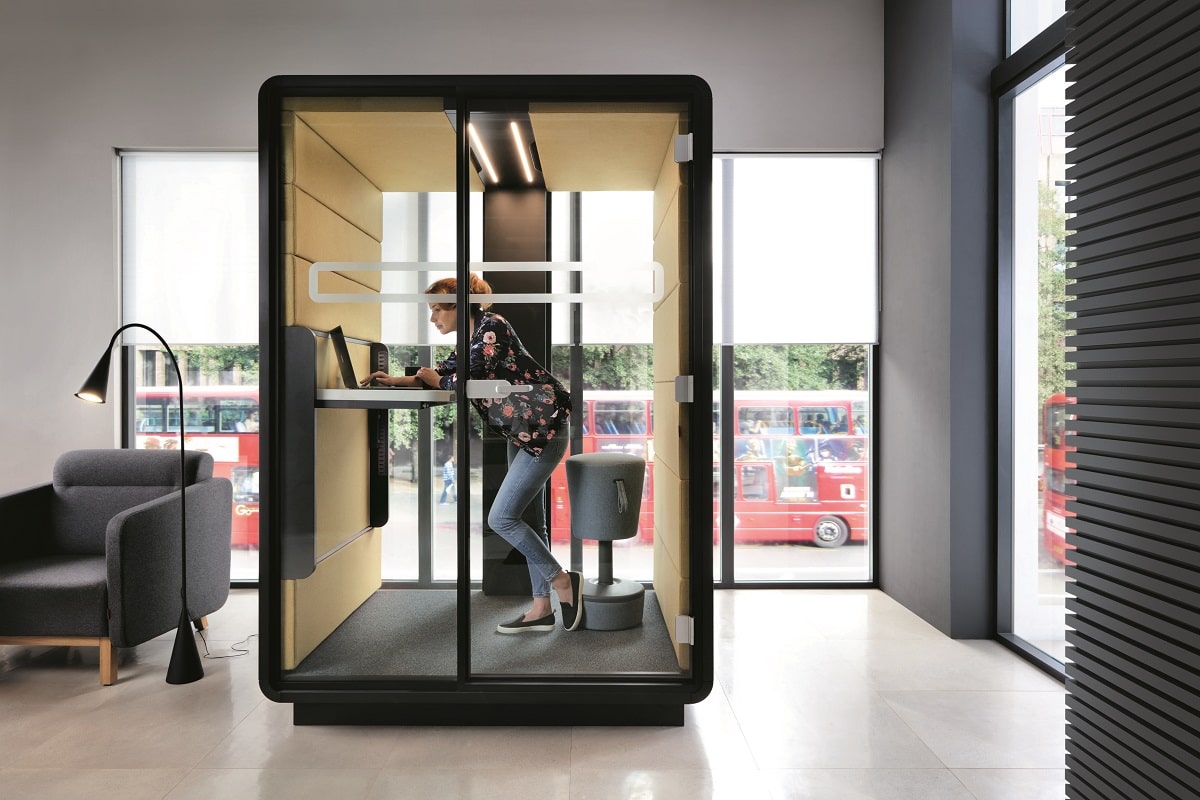
Solutions for each office acoustic problems
Does your space echo? Is it awkwardly quiet? Does it lack speech privacy? It is just plain rampant with noise from calls, meetings, and collaboration? The following fixes target each problem, respectively.
If your space echoes, add “fuzz” with soft, noise dampening materials.
The great thing about sound-absorbing ceiling tiles, acoustic wall panels, acoustic dampening curtains, and the like is that they’re often customizable. They can fit any space. They come in a wide range of materials, colors, and shapes, too. So they give a lot to your office’s aesthetic.
Noise dampening acoustic treatments are also relatively affordable.
Especially compared to professional-grade commercial office sound masking systems. And you can add and reconfigure treatments one by one, tile by curtain until the desired sound quality is achieved. The sweet cherry on top? Soft materials make any environment more cozy. They impart a homey feel.
17 smart acoustic treatments to consider…
Suspend noise-dampening ceiling tiles, foams, panels, baffles, or clouds. Ceiling-mounted acoustic paneling makes a big difference in a boomy space with high ceilings.
Consider sound dampening flooring, carpeting, and area rugs. Cork, rubber, and vinyl are super options for better office acoustics. Carpets and rugs are available in acoustic materials, too.
Line the underside of desks with a sound insulating material like foam. Such a minor retrofit can make sizable headway into noise at shared working areas.
Equip your team with noise canceling headphones, headsets, and earbuds. Noise buffering microphones are worth looking into as well.
Go green. Plants are awesome sound absorbers! Planters, living walls, and Green Walls work beautifully. Species that dampen sound particularly well include fiddle-leaf figs, ferns, palms, peace lilies, rubber plant, weeping fig, and norfolk island pine. As a brilliant bonus, plants purify the air and promote well-being. For inspiration, check out our Green Wall, an all-in-one living wall system that secures to either side of a Hushoffice pod, turning pod walls into vertical gardens.
Finish hard walls with sound dampening tiles and sound absorbing panels. These are often made of mineral wool, foam, wood, fiberglass, or polyester. They come in every shape and size imaginable, fitting the space’s dimensions and “look.” Say you need to give one zone a little more speech privacy. Surfacing this zone’s main wall with sound deadening tiles or panels will assist.
Shop around textile wall hangings. Another superb treatment, both decorative and functional.
Go “soft” on new furniture. Upholstery should be fibrous. Chairs, storage solutions, workstations, and shelving can often be ordered or updated with such acoustic fabric. Soundproofed furniture makes a significant difference because it captures sound right at the source. Take the A11 acoustic lounge chair for example. It gives employees a cozy, luxury spot to chill as it dampens office noise.
Retrofit existing furnishings with sound panels. Surface and secure decorative, sound dampening panels to existing furniture for more sound-absorption.
Check out soundproof office screens. Screens are semi-solid, so they let some light, visibility, and energy through. They provide a moderate level of privacy without compromising a space’s openness.
Fill open bookcases with books. Books make excellent sound dampeners because they are porous. As a general rule, the more porous materials your space features, the less that sound will bounce around.
Surface furniture feet with a soft material. This way, chairs and tables won’t screech when slid.
Invest in sound absorbing desk mats. Acoustic matsreduce sound reverberation from the desk. They’re also softer and more enjoyable to work on for most employees.
Finish workspaces with acoustic desk divider screens or desktop partitions. Desk partitions deter noise from neighboring colleagues while giving each employee more isolation and quiet in their own space.
Opt sound-absorbing for all lighting fixtures. Gorgeous and useful. Where light is needed, opt sound-absorbing.
Get noise dampening curtains, shades, and blinds. If you’re blocking noise from outside, high-quality curtains, shades, and blinds will help.
Throw on a fresh coat of noise reducing paint. This easy fix helps soundproof a wall.
Where do I place my acoustic treatments? A rule of thumb…
Survey your space in question. Identify all hard surfaces. Identify where the shortest distance between hard surfaces lies. One or both of these hard surfaces should be acoustically treated (finished with tiles, panels, upholstery, or some other material outlined above).
Sound waves bounce off the closest hard surfaces by nature.
And ricochet between the two. By soundproofing one of both of said surfaces, you prevent the ricochet. Say you’re soundproofing a conference space. You’ll want to treat both the conference table and nearest wall off of which sound bounces most.
If your office is uncomfortably quiet, consider a sound masking system.
Employees benefit from ambient sound. Without it, they feel uncomfortable.
For one, they’re concerned about distracting others, which creates stress.
If it seems like a pin drop can be heard, people will be discouraged from working as they naturally do…
… i.e., speaking under their breath to talk through problems or asking colleagues for quick feedback. So productivity is hindered.
A soft, uniform, background, ambient sound will help restore a productive soundscape by making the space simply feel comfortable.
Opt for a white noise machine, generator, or system modeled after nature. Dynamic sounds are generally better than repetitive ones. This is because repetition is draining for most people, while dynamic sounds tend to be generative.
If speech privacy is lacking, look to speech privacy systems.
Noise can be slick. It can subtly jeopardize calls with clients, meetings with partners, and other high-priority conversations in several ways.
For starters, it can take anyone out of the moment. So there’s the chance of missing or mishearing. At the same time, people are often inhibited by concern of being overheard when their space doesn’t feel soundproofed. So their open expression may be stunted. When the conversation is sensitive or confidential, this problem is significant.
In a nutshell, bad speech privacy limits both connection and opportunity.
This is why speech/acoustic privacy is foundational. When employees have it, they’re neither distracted by sounds around them nor worried about being listened to. When they don’t have it, focus is hard. Speech privacy systems, space division, and office pods and booths can help. Those soft sound insulating treatments aid, too.
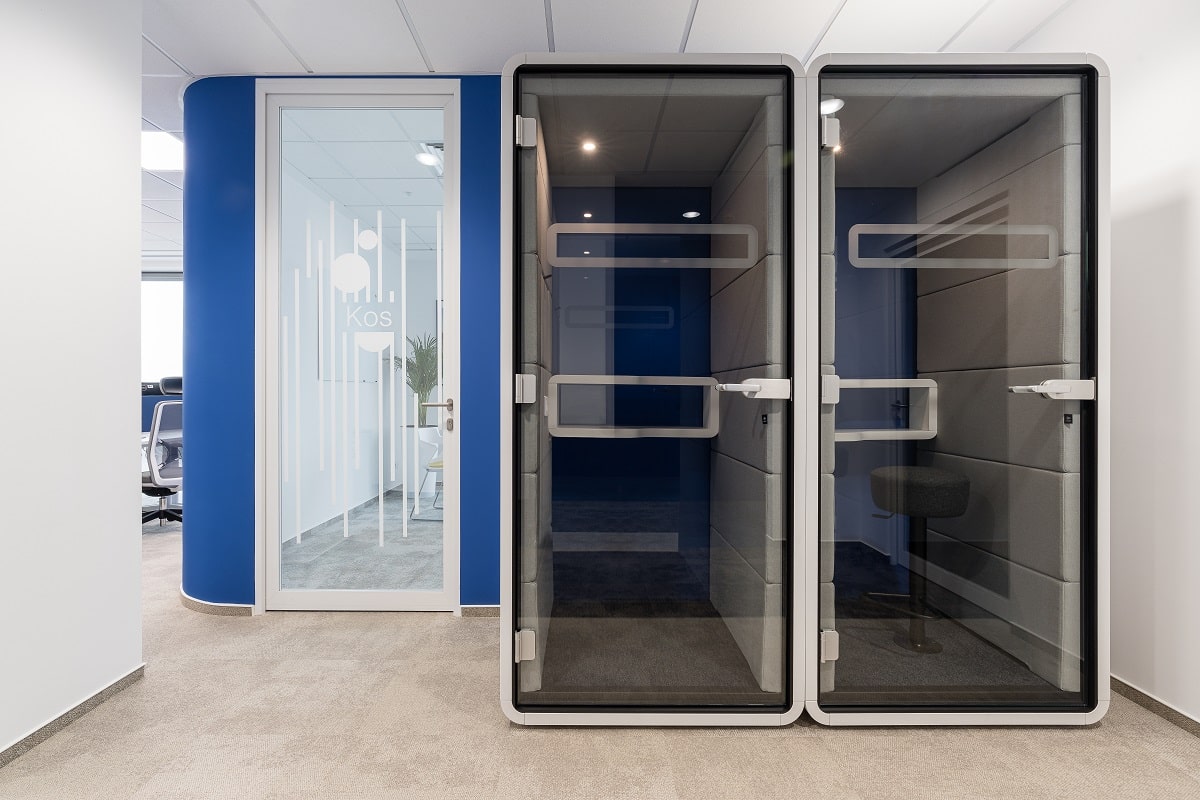
If your office is plain noisy, use soundproof office booths and pods.
Perhaps your floor is fraught with noise from calls, meetings, and collaboration. You need to contain all three. Acoustic pods are cut out for the task because they’re designed for specific work functions. They thereby contain the most problematic sources of noise on an open floor one by one. And they’ve become super popular in recent years because they’re a true twofer. They insulate noise and lend privacy at once.

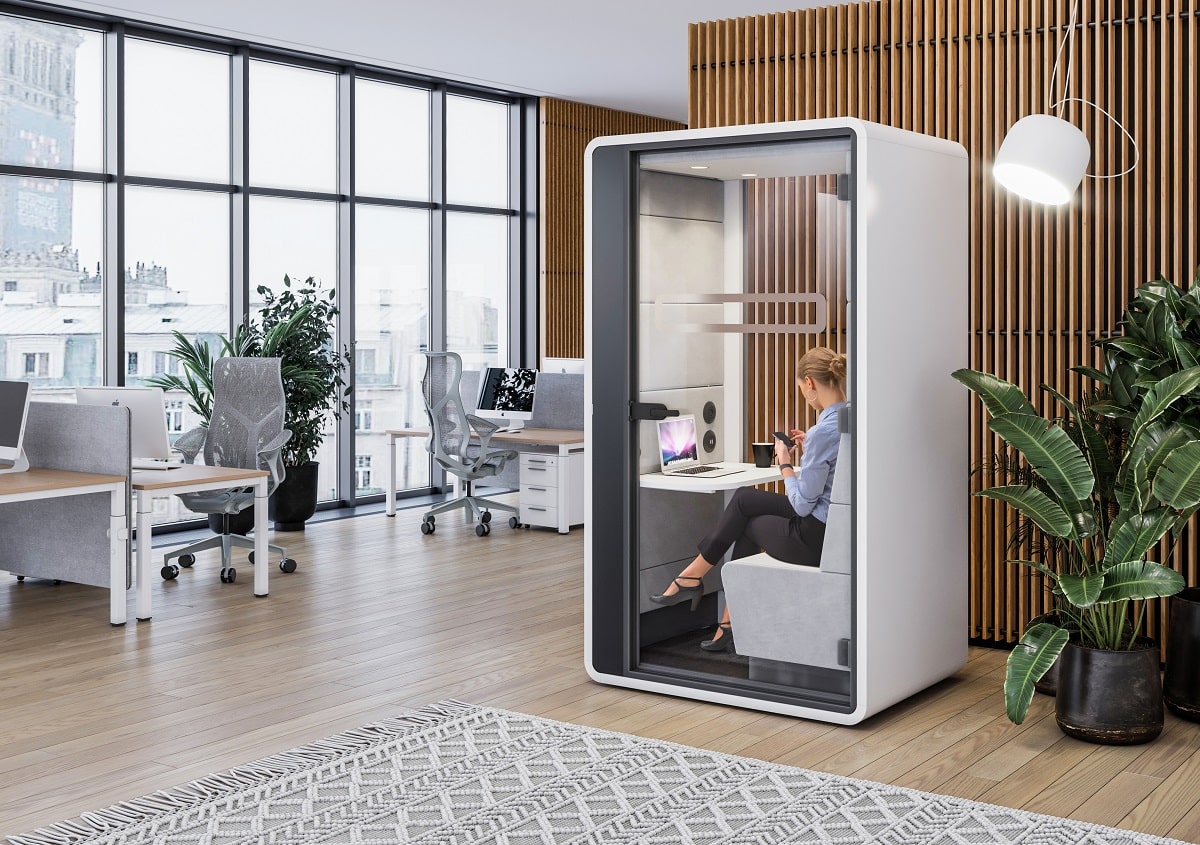

11 signs soundproof office pods are the fix for you
How to know for sure if pods are for you?
- Your main conference or meeting rooms are always booked
- Visual, architectural, or acoustic (speech) privacy is inadequate
- Employees are often stepping outside to take calls
- Teams fight over limited private meeting or work spaces
- Focus is often broken by background office noise
- Colleagues are frequently distracted by one another on the open floor
- Autonomy is insufficient; employees are anxious or stressed, with little control over their work environment (light, sound, visuals, ventilation, and physical workspace)
- There aren’t enough spaces for private meetings, video calls, or heads-down work
- Infrastructure is out of the question
- Mobility in the form of mobile office furnishings is desired
- An office relocation is on the horizon, and you don’t want to invest in infrastructure just to leave it behind
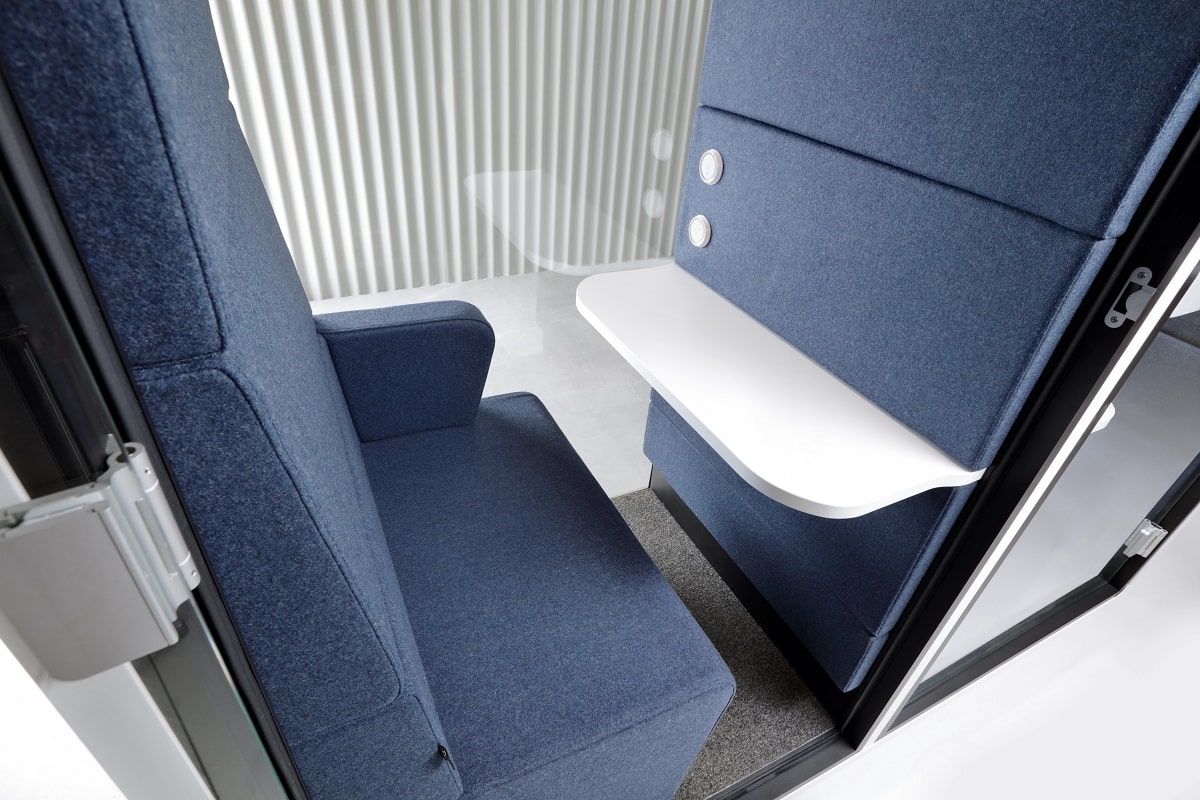
Seeking agility? Read more about how mobile furniture empowers an agile workplace: Mobile furniture, the flexibility an agile office needs.
So what noise problems does your office space exhibit? Does it echo? Is it too quiet? Or too noisy? Does it fail to provide adequate speech privacy? Check out the Hushoffice collection of acoustic workplace furniture as you peruse office noise solutions. Each pod is flexible and modern, supporting focus on the open floor regardless of the task at hand. They help fully realize the open space concept by giving employees the peace, quiet, and control needed for effective working. Have questions? Leave the Hushoffice team a note here!
Summary…
-
Sound is a good thing. Beneficial, or biophilic sound is conducive to focus and well-being. This is why acoustic solutions like office pods and booths are comfortably quiet, not totally quiet. They convert a distracting ~70dB blare into a calming ~40dB hum.
-
10 best practices for managing office noise at an organizational level.
-
Solutions for each office acoustic problem… If your office echoes, add “fuzz” with soft, noise dampening material. If it’s uncomfortably quiet, consider a sound masking system. If it lacks speech privacy, look to speech privacy systems, space division, and office pods/booths. If it’s just plain noisy with calls, meetings, and collaboration, “trap” the worst noise offenders with acoustic cabins for the office.
-
The rule of thumb: where to place your acoustic treatments.
- 11 signs that portable, soundproof office pods are the right solution for your office noise problem.
Office noise – frequently asked questions
What should I do if my office echoes?
Add “fuzz” to your space using soft, noise dampening materials like sound dampening ceiling tiles, acoustic wall panels, and acoustic dampening curtains. Flooring, carpeting, furniture, plants, walls, and workstations can all be completed with acoustic materials.
Where do I place acoustic treatments in the office?
Identify where the shortest distance between hard surfaces lies in the given space. Acoustically treat one or both of these surfaces using sound absorbing tiles, panels, upholstery, or other sound-absorptive material.
